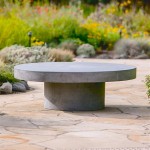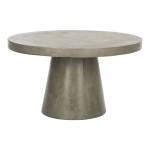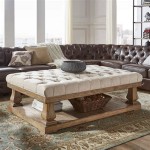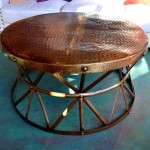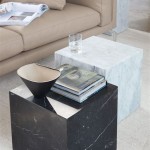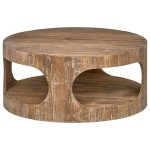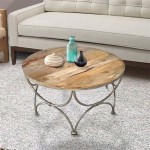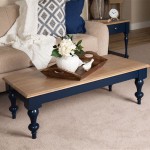Center Table Modern Design Ideas for Living Room
The center table, often referred to as a coffee table, is a pivotal element in any living room's design. It serves as a functional surface for placing drinks, books, and decorative items, whilst simultaneously contributing significantly to the overall aesthetic. In modern interior design, the center table is no longer a mere afterthought; it is a statement piece that can define the room's style and character. Selecting the right modern center table requires careful consideration of factors such as size, shape, material, and design, all of which must harmonize with the existing décor and meet the specific needs of the inhabitants.
Modern center table designs emphasize simplicity, functionality, and clean lines. They often incorporate minimalist principles, focusing on essential forms and eschewing excessive ornamentation. This emphasis on simplicity allows the table to blend seamlessly with a variety of interior styles, from Scandinavian and industrial to mid-century modern and contemporary. The following sections will explore various design ideas for modern center tables, providing insights into different materials, shapes, and styles to help individuals make informed decisions for their living spaces.
Material Considerations for Modern Center Tables
The choice of material is paramount in determining the appearance, durability, and overall feel of a modern center table. Various materials offer distinct aesthetic qualities and functional benefits, impacting the table's maintenance requirements and suitability for different lifestyles. Common materials used in modern center table designs include wood, glass, metal, and stone, each possessing unique characteristics that can enhance the living room's ambiance.
Wood: Wood is a timeless and versatile material that brings warmth and natural beauty to any living room. Solid wood tables, like oak, walnut, or maple, offer exceptional durability and a rich textural appeal. Wood can be stained in various shades, allowing it to complement different color schemes and design preferences. Light-colored woods, such as birch or ash, are often favored in Scandinavian-inspired interiors, while darker woods, like mahogany or rosewood, can create a more sophisticated and formal atmosphere. Engineered wood, such as plywood or MDF with wood veneer, offers a more cost-effective alternative to solid wood, while still providing a similar aesthetic. These materials are also less prone to warping or cracking due to changes in humidity. It is essential to consider the type of wood finish used, as it can affect the table's resistance to scratches, stains, and moisture. A durable polyurethane finish or a natural oil finish can help protect the wood and enhance its longevity.
Glass: Glass center tables offer a sleek and contemporary aesthetic that can create a sense of openness and airiness in the living room. Glass is available in various forms, including clear, frosted, tinted, and tempered. Clear glass tables are ideal for showcasing the rug or flooring beneath, while frosted glass provides a more subtle and diffused look. Tinted glass can add a touch of color and sophistication to the room. Tempered glass is a safety feature, as it is significantly stronger than standard glass and shatters into small, blunt pieces rather than sharp shards if broken. Glass tables often feature a metal or wood base, providing structural support and adding visual contrast. Glass tables are relatively easy to clean and maintain, but they can be susceptible to scratches and fingerprints, requiring regular cleaning with a glass cleaner.
Metal: Metal center tables exude a modern and industrial aesthetic, characterized by clean lines and geometric shapes. Common metals used in center table designs include stainless steel, wrought iron, brass, and copper. Stainless steel offers a sleek and minimalist look, while wrought iron provides a more rustic and traditional feel. Brass and copper can add warmth and elegance to the room. Metal tables are often powder-coated or finished with a protective coating to prevent rust and corrosion. Metal tables are generally durable and easy to clean, but they can be prone to scratches and dents. It is important to consider the weight of the metal table, as some metal tables can be quite heavy and difficult to move.
Stone: Stone center tables, such as marble, granite, or slate, offer a luxurious and sophisticated aesthetic that can elevate the living room's ambiance. Marble tables are known for their elegant veining and smooth, polished surface, while granite tables offer a more rugged and textured appearance. Slate tables provide a naturally dark and dramatic look. Stone tables are extremely durable and resistant to scratches and stains, but they can be porous and require sealing to prevent absorption of liquids. Stone tables are also quite heavy and require a sturdy base for support. The cost of stone tables can vary significantly depending on the type of stone and its quality.
Shape and Size Considerations for Modern Center Tables
The shape and size of the center table should be carefully considered to ensure it complements the living room's layout and functionality. A table that is too large can overwhelm the space, while a table that is too small may not provide adequate surface area. The shape of the table can also influence the room's flow and visual balance. Common center table shapes include rectangular, square, round, and oval, each offering distinct advantages and disadvantages.
Rectangular: Rectangular center tables are a popular choice for larger living rooms, as they provide ample surface area and complement the shape of most sofas. They are particularly well-suited for rooms with a long and narrow layout. A rectangular table can be placed parallel to the sofa, creating a cohesive and balanced look. The length of the table should be approximately two-thirds the length of the sofa, allowing for comfortable access and circulation around the table. Rectangular tables with storage shelves or drawers can provide additional functionality, offering a convenient place to store books, magazines, or remote controls.
Square: Square center tables are ideal for smaller living rooms or seating areas, as they provide a compact and symmetrical design. They work well with L-shaped sofas or sectional sofas, creating a balanced and harmonious look. The size of the square table should be proportional to the size of the sofa, ensuring it does not overwhelm the space. Square tables can also be used in pairs to create a larger surface area when needed. They are a versatile option that can be easily moved and rearranged to suit different seating arrangements.
Round: Round center tables offer a softer and more organic aesthetic, creating a sense of warmth and invitation in the living room. They are particularly well-suited for smaller spaces, as they eliminate sharp corners and promote a smoother flow of traffic. Round tables work well with curved sofas or seating arrangements, creating a harmonious and balanced look. They are also a good choice for families with young children, as they pose less of a safety hazard than tables with sharp corners. The diameter of the round table should be proportional to the size of the sofa, ensuring it does not overwhelm the space.
Oval: Oval center tables offer a similar aesthetic to round tables but provide a slightly larger surface area. They are a good compromise between rectangular and round tables, offering a balance of functionality and style. Oval tables work well with a variety of sofa shapes and seating arrangements, creating a cohesive and balanced look. They are also a good choice for families with young children, as they eliminate sharp corners and promote a smoother flow of traffic. The length and width of the oval table should be proportional to the size of the sofa, ensuring it does not overwhelm the space.
Style and Design Elements in Modern Center Tables
The style and design elements of a modern center table should reflect the overall aesthetic of the living room. From minimalist and industrial to Scandinavian and mid-century modern, various design styles offer distinct characteristics and visual appeal. Incorporating specific design elements, such as geometric shapes, unique finishes, and decorative details, can further enhance the table's aesthetic and create a focal point in the room.
Minimalist: Minimalist center tables emphasize simplicity and functionality, characterized by clean lines, geometric shapes, and a lack of ornamentation. They often feature neutral colors, such as white, black, or gray, and are made from materials such as glass, metal, or wood with a simple finish. Minimalist tables blend seamlessly with a variety of interior styles, creating a sense of openness and airiness in the living room. They are a good choice for individuals who prefer a clean and uncluttered aesthetic.
Industrial: Industrial center tables draw inspiration from factories and warehouses, characterized by raw materials, exposed hardware, and a utilitarian design. They often feature metal frames with wood or concrete tops, creating a rugged and urban aesthetic. Industrial tables can add a touch of character and edge to the living room, particularly in loft apartments or modern homes with exposed brick and concrete walls. They are a good choice for individuals who appreciate a unique and unconventional style.
Scandinavian: Scandinavian center tables emphasize natural materials, light colors, and functional design, characterized by clean lines, simple shapes, and a focus on comfort and practicality. They often feature light-colored wood, such as birch or ash, and incorporate elements such as woven baskets or felt accents. Scandinavian tables create a warm and inviting atmosphere in the living room, promoting a sense of calm and relaxation. They are a good choice for individuals who appreciate a minimalist and nature-inspired aesthetic.
Mid-Century Modern: Mid-century modern center tables draw inspiration from the design trends of the 1950s and 1960s, characterized by clean lines, organic shapes, and a focus on functionality and innovation. They often feature materials such as wood, metal, and glass, and incorporate elements such as tapered legs, geometric patterns, and bold colors. Mid-century modern tables add a touch of retro charm and sophistication to the living room, creating a stylish and timeless look. They are a good choice for individuals who appreciate classic design with a modern twist.
Choosing the right center table involves a holistic approach, considering all these aspects to ensure the final selection is both aesthetically pleasing and practically functional within the living room environment.

How To Style Your Modern Center Table

5 Decoration Tips On How To Style Modern Center Tables

39 Easy Center Table Decor Ideas And Tips For Your Living Room Carla Bast Design

50 Luxury Center Tables That Deserve Your Attention

Upgrade Your Living With These Modern Center Tables Home Decor Ideas

5 Decoration Tips On How To Style Modern Center Tables

50 Luxury Center Tables You Should Look Out For

Anbazar Rectangular Coffee Table Tea Metal Frame 2 Tier Tempered Glass Shelves For Living Room Waiting White Wjz 019

Top 10 Choices On Modern Center Tables For Your Living Room

Tribesigns Way To Origin Inaayah 31 7 In White Gold Small Round Mdf Coffee Table With Storage Modern Center For Living Room Hd Ny148 Hyf
Related Posts

